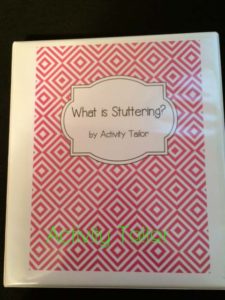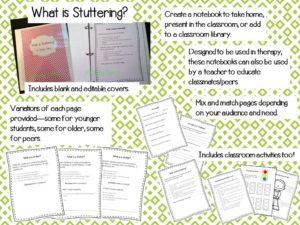I’ve posted about using speech notebooks in the past. Since I’m in a school setting, it’s a great way for my students to show their teacher and parents what we’ve been working on and keeps home activities in a place where they are most likely to be found (found not necessarily done!).
With back-to-school activities abounding on the internet, I got to thinking about some of my fluency students and a combination “about me” and “speech notebook” came together.
“What is Stuttering” is designed for a few purposes. The first is for individual students use as an exercise in individual or small group therapy. I’m planning to have my students complete sheets (two age variation provided) such as:
- My Stutter
- What is a stutter?
- What causes stuttering?
- What helps when you stutter?
- Famous people stutter too!
- Strengths and challenges
These sheets can be assemble into a thin notebook and presented either in therapy or in the classroom. In some situations, I’m hoping the notebook will become part of the classroom library to help educate others in the classroom. Editable covers (or blank covers) are included.
Along those lines, I’ve added variations of the sheets that are designed specifically for educating peers. These could be presented to a classroom or small group by the SLP, teacher or even the child with fluency issues. Worksheets include:
- What is a stutter?
- What causes stuttering?
- How can I help when someone stutters?
- What listening looks like
- Famous people stutter too!
- Strengths and challenges
- Stop light questions (myth busting questions)
How do you handle classroom education on fluency disorders? I’m interested to hear how others handle these tricky situations!
For more information you can check out What is Stuttering? in my TpT store. Also, if you have my Fluency Game Mats, they were recently updated with six new mats, many of which are especially appropriate for fall. Be sure to redownload!










This Post Has 3 Comments
I’m sorry this note is in all caps. I cannot seem to change this setting.
I respectfully suggest that an information worksheet with the heading “What Causes Stuttering?” explain quite clearly that we do not know the cause and provide child-friendly links to reliable online sources of information, such as the National Stuttering Association and the Stuttering Foundation. to imply that a busy family that talks quickly might cause stuttering is like saying a family that reads too much causes vision impairment, imho.
Judy, Thank you so much for your input. I put a lot of thought into how best to present the facts to a younger audience (under 2nd grade), but will be taking your suggestions into account and making a revision. My information came directly from the Stuttering Foundation and had hoped I was conveying that we don’t know what causes it, but that these factors are thought to be contributors. The worksheet version for older students more specifically says, “While no one knows for sure, the following four factors are thought to play a role” and then each item is described in more detail (ex. Genetics: approximately 60% of stutterers have a family member that does too; Family dynamics: Fast paced talking and life style environments can make stuttering more likely.) and goes on to ask “What factors do you think play a role in your own stutter?” If you have specific verbage you think might assist for the younger grades, I’m all ears! Kim
My apologies; I see the letters did not remains caps when posted.
Comments are closed.